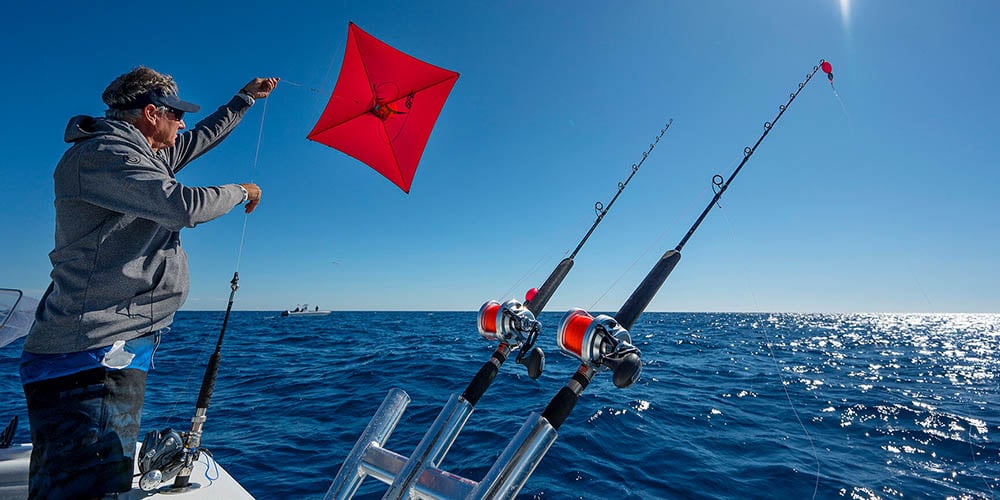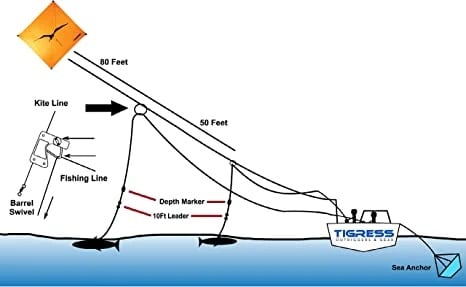
Is it hang gliding for baits, kite-sailing for greenies? Nope, it’s kite fishing, and it’s a great way to deploy live baits for tuna, marlin, sailfish and other predator game fish. Invented in China, long practiced in New Guinea and other Pacific Islands, kite fishing enables off-the-beach surf anglers to deploy lines and hooks out past the breakers.
Since fishing icon Bob Lewis introduced kite fishing to billfish anglers in South Florida, its popularity has grown immensely. Bob figured out the advantages of using a kite—keeping the wiggly live bait swimming attractively just below the surface with the heavier leader line hanging vertically above the bait and out of the water, less likely to spook wary predators. Experienced anglers multiply their chances of catching fish by flying up to three kites—each with up to three baits suspended beneath it—for a total of up to nine baits in the water.
Kite Fishing Equipment
Fishing kites are square and typically have a carbon-graphite frame across which is stretched rip-stop nylon fabric. Anglers fly kites with 50-, 80- or 100-pound Spectra or Dacron line connected to a stubby rod and a powerful reel. Electric reels are often employed, since reeling in a kite producing 15-20 pounds pressure can be tiresome. Kites vary in size and weight to accommodate light to heavy winds.
We suggest you carry an assortment of kites to accomodate different wind speeds and because you will need another if the kite line breaks and you lose your kite to Davy Jone's locker. Also, pulling a kite that’s ten feet underwater back to your boat is a big challenge, so some captains attach a small party balloon to the back side of their kite to keep it afloat to save precious minutes while retrieving it during a tournament. Helium balloons are used in light wind to help support the kite.
Each kite’s line has one or more release clips, like those used on outriggers, strung at intervals along the kite line; and each clip is assigned to a rod and reel. As many as three baits are suspended below each kite. When multiple kites are flowen, anglers place small weights on the edge of each kite to control the direction they want to fly and prevent them from crossing over each other. The diagrams below depict what this looks like.
Mono-filament or fluorocarbon are attached to a fishing reel’s main line with a neon-colored Styrofoam marker about the diameter of your forefinger, with a snap swivel. These markers hover in the air above each of your baits and indicate their location. A dual or three-way rod holder on the transom holds your kite rod and one or two additional rods.
Kites can also be used from shore anywhere you have the wind at your back, allowing boat-less anglers with a little creativity to present baits way beyond normal casting range. With the right gear, kite fishing is easier than it looks.
Kite Rods and Reels
In addition to your preferred rods and reels for billfishing, for each kite that you fly, you will need a dedicated kite rod and reel.
Low-speed conventional reels like the Penn Senator 114H2 make a great choice for a kite reel. Power assist electric reels are recommended for even greater convenience, but at a substantially higher price. We stock a range of Daiwa electric reels that connect to a deep cycle battery with alligator clips, plug into a waterproof receptacle, or use a Lithium battery pack.
Kite rods are short and heavy, often with just one ring guide at the tip, about 3' in length. Their singular job is to hold the kite line. Your other rods hold your baits.
Sea Anchors
Kite fishing is often done while drifting as slowly as possible the bow to the wind or with the boat perpendicular to the wind. To do this, a sea anchor or drogue is attached to the boat's bow or to an a cleat amidships.
Kite Fishing Drift Technique

Drifting is the most popular approach to kite fishing, punctuated by surface strikes from aggressive game fish. Using two kites weighted to fly to the left and right with multiple baits off each kite line to achieve maximum surface coverage. In fact, flat lines used on the upwind side of the boat provide even more coverage. Using a sea anchor to slow the boat's drift can help the kite fly better.